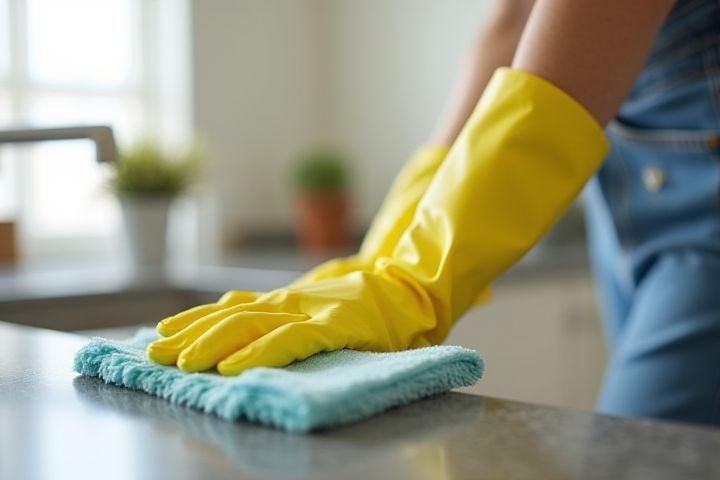
House cleaning frequency varies based on lifestyle and individual preferences, but a comprehensive cleaning schedule can enhance your home's hygiene. Generally, focusing on daily tasks like making beds and washing dishes promotes a tidy atmosphere. Weekly deep cleaning activities, such as vacuuming carpets and mopping floors, help eliminate dirt and allergens. Monthly chores, including dusting ceiling fans and washing windows, keep your space looking fresh and welcoming. For a thorough seasonal clean, tackle less frequent tasks like decluttering closets and deep-cleaning appliances, ensuring your home remains a healthy and comfortable environment.
How Regularly Should You House Clean
Dust surfaces weekly
Dust surfaces in your home should be cleaned weekly to maintain a healthy environment, particularly for allergy sufferers. Dust accumulation can contain harmful allergens like pollen, pet dander, and dust mites, potentially affecting air quality and overall well-being. In high-traffic areas or spaces with pets, consider cleaning these surfaces more frequently, perhaps two to three times a week. This simple habit can significantly reduce dust buildup, improving indoor air quality and creating a more pleasant living space.
Vacuum carpets and rugs weekly
Vacuuming carpets and rugs weekly is essential for maintaining optimal indoor air quality and extending the lifespan of your flooring. This routine helps in removing dust, dirt, and allergens that accumulate over time, creating a healthier living environment for you and your family. To effectively combat pet hair and dust mites, consider using a vacuum cleaner equipped with a HEPA filter for better filtration. Regular cleaning not only enhances the appearance of your carpets but also contributes to the overall comfort of your home.
Sweep and mop floors weekly
Sweeping and mopping floors should be performed weekly to maintain a clean and hygienic living space. Regularly removing dust, dirt, and allergens helps improve indoor air quality and reduces the risk of respiratory issues. If you have pets or live in a high-traffic area, consider increasing the frequency to twice a week for optimal cleanliness. For best results, use appropriate cleaning solutions that suit your floor type, ensuring a thorough clean while preserving the surface's integrity.
Clean bathrooms weekly
Clean bathrooms at least once a week to maintain hygiene and prevent the build-up of mold, mildew, and bacteria. High-traffic areas such as countertops, sinks, and toilets require frequent attention, ideally with disinfecting wipes or spray cleaners. On average, spending 20 to 30 minutes on each bathroom can significantly improve cleanliness and freshness. You may consider creating a cleaning checklist to ensure all surfaces and fixtures are addressed during your weekly cleaning routine.
Laundry once or twice a week
For optimal household hygiene, focus on laundry once or twice a week, depending on your lifestyle and needs. Washing bed linens every week helps eliminate allergens and maintain freshness, while clothing can typically be laundered bi-weekly if not heavily soiled. Consider washing towels and kitchen cloths once a week to prevent bacteria buildup. Setting a cleaning schedule can enhance your living environment, keeping it organized and comfortable.
Clean kitchen surfaces daily
Cleaning kitchen surfaces daily is essential to maintain hygiene and prevent the build-up of bacteria. This practice helps reduce the risk of foodborne illnesses, ensuring a safe cooking environment for you and your family. Regularly disinfecting countertops, stovetops, and high-touch areas can significantly enhance the cleanliness of your kitchen. Adopting this daily routine contributes to a healthier home and can save you time on deeper cleaning sessions later on.
Empty trash bins weekly
Emptying trash bins should be a weekly task to maintain a clean and hygienic home environment. If you have multiple bins, designate a specific day to ensure none are overlooked; for instance, Sunday is an excellent time to focus on waste management. Regularly emptying your bins can prevent unpleasant odors and discourage pests. Always remember to sanitize the bins every month for optimal cleanliness and to enhance your indoor air quality.
Change bed linens bi-weekly
Changing bed linens bi-weekly is essential for maintaining a clean and healthy sleeping environment. Regular linen changes help eliminate dust mites, allergens, and bacteria that can accumulate, ultimately improving your sleep quality. This practice also prolongs the life of your bedding by reducing wear from accumulated dirt and body oils. To ensure consistency, consider setting reminders or establishing a cleaning schedule to incorporate this habit into your routine.
Clean windows seasonally
Cleaning windows seasonally, typically four times a year, ensures optimal clarity and enhances your home's curb appeal. During spring and fall, focus on removing accumulated dirt, dust, and grime, which can impair your windows' effectiveness. This routine not only improves natural light entering your home but also extends the lifespan of your windows by preventing potential damage from buildup. You may find that scheduling this task alongside your other seasonal cleaning makes it more manageable and efficient.
Deep clean seasonally
A deep clean should be performed at least once every season, totaling four times a year, to effectively maintain a healthy living environment. This process involves tackling areas often overlooked during routine cleaning, such as vents, baseboards, and behind appliances. By setting a schedule for deep cleaning each season, you ensure that allergens and dust don't accumulate, significantly improving indoor air quality. To optimize your efforts, create a comprehensive checklist for each deep clean, targeting different rooms or tasks each time.
